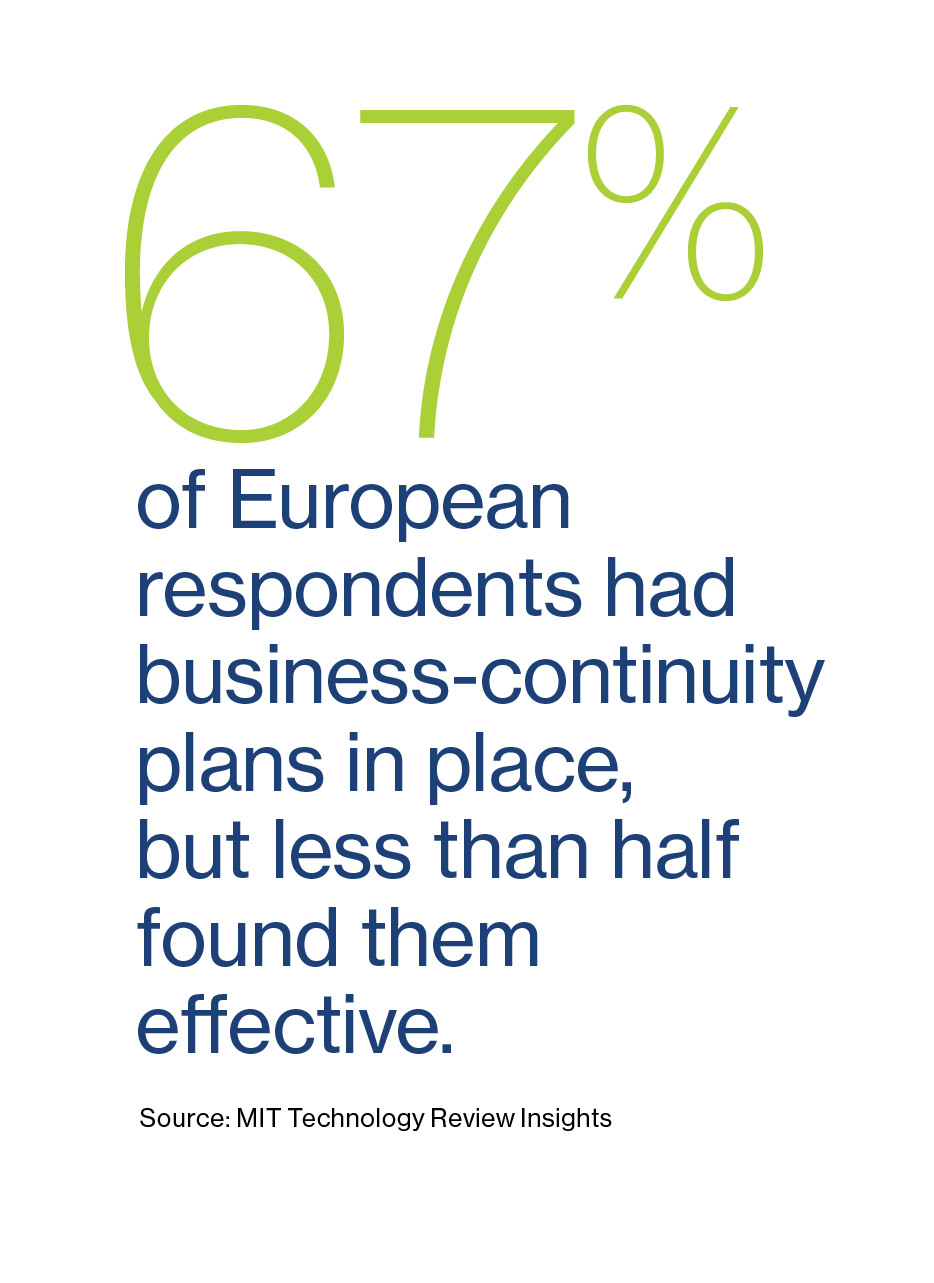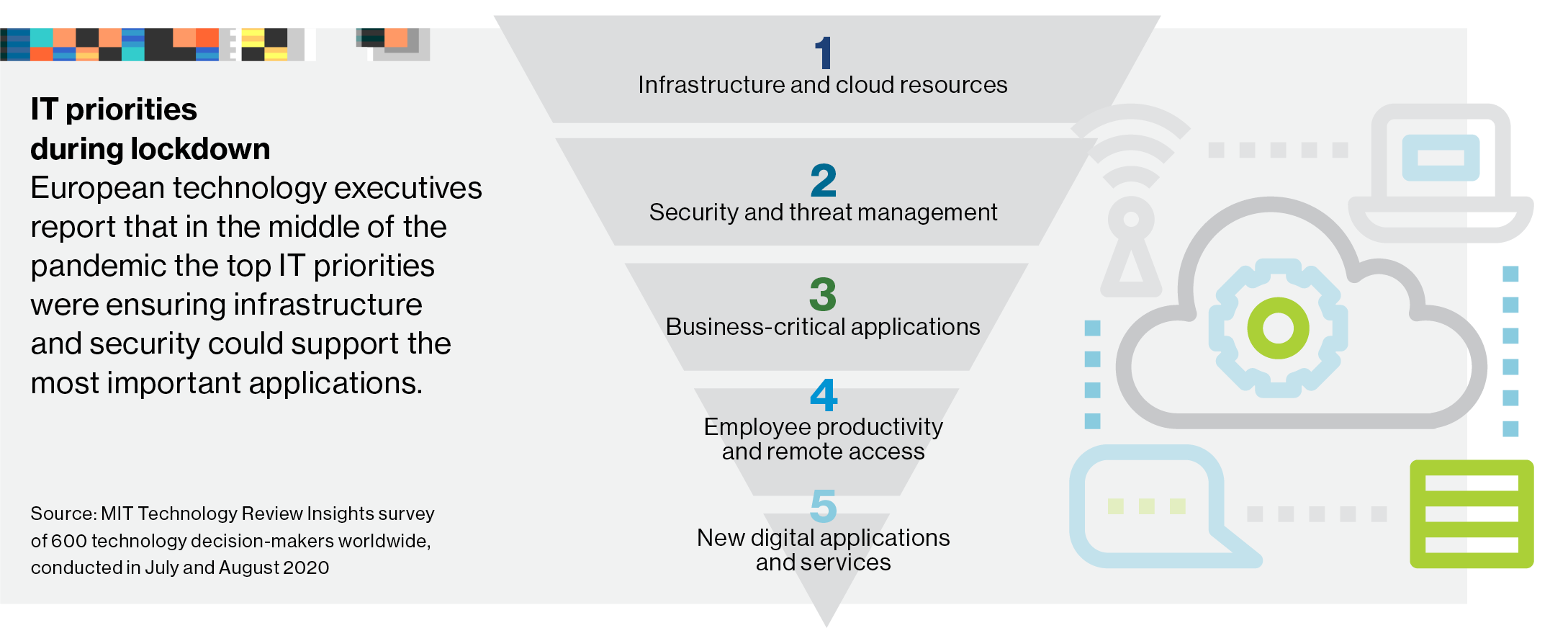Sponsored
Digital acceleration in the time of coronavirus: Europe
European businesses reinvented themselves amid pandemic-driven disruption, reshuffling tech priorities and pursuing new opportunities.
In association withVMware
This MIT Technology Review Insights report is part of a series examining the degree to which business preparedness, particularly in technology strategy, contributed to corporate resilience during the ongoing coronavirus pandemic in three world regions: Asia-Pacific, Europe, and North America. Based on survey research and in-depth executive interviews, the series also seeks to understand how technology priorities are changing as a result of ongoing business-continuity efforts.

Digital acceleration in the time of coronavirus: Europe
No business strategist could have foreseen that the world would have been thrown into the economic and social crisis wreaked by a fast-moving pandemic, even in Europe, where covid-19’s spread began to take its toll nearly a year ago. Even those with the clearest of crystal balls would not have been able to sidestep the impact of a virulent disease that has cost the global economy 14% of its working hours in the second quarter of this year, according to the International Labour Organization—equivalent to 400 million full-time jobs. A recent survey of 600 technology decision-makers worldwide, conducted by MIT Technology Review Insights, in association with VMware, found that 67% of European respondents had business-continuity plans in place, although less than half of them found them effective.
That said, one segment of tech leaders saw their continuity efforts pay off: European organizations that already invested in digital transformation—defined in the survey as efforts to incorporate modern technology into processes and strategies to achieve business goals. These organizations have fully implemented at least one digital transformation project, all of them report that their recovery plans were effective, and more than a third of them say they were very effective. This “digital leader” cohort—representing some 15% of European respondents—points to an important intersection between planning for business disruption and a commitment to investment in enabling technology. These efforts have allowed digital leaders to absorb the shock of the pandemic and transition to remote working processes and online commerce with relative ease.
‘We had to reinvent ourselves’

Digital leaders in Europe and elsewhere were therefore largely prepared for what they hadn’t anticipated: a near complete move to online commerce and at-home working. “We have seen over the last few months a massive shift in how firms operate, and how people operate. We are all looking through glass: using digital channels to work from home, bank from home, shop from home, socially interact from home,” observes Mike Dargan, chief information officer at Zurich-based investment bank UBS. The company’s investment in technology approximately $3.5 billion a year—has armed his team with the capabilities to make the shift. “The way we’ve operated, we could have basically everyone working from home—more than 95% of our people are enabled to work remotely.” UBS had up to three million calls on communication service Skype a week and at one point a 70% increase in customer engagement onboarding through its mobile app.
UBS’s experience was largely in line with survey results: ensuring that infrastructure remained robust and essential applications stayed online throughout the ensuing lockdowns were European respondents’ top priorities. In all, 73% say their responses to the pandemic have caused them to step up their digital transformation efforts. But they’re building on a solid foundation of digital investment—and this, in turn, has helped them navigate the upheaval. “Fifteen years ago, it would have a completely different result—we would not be prepared culturally or technically,” says João Günther Amaral, chief development officer at Sonae, a Portuguese retail, communications, and finance conglomerate. “We would not have the capacity to send 6,000 people home and have them work immediately and effectively.”
Amaral says “digitally assisted confinement,” as he calls it, has worked surprisingly well, in part because expectations for working almost entirely online were low. “We were really surprised with the quality of everything: the quality of videoconferencing and collaboration tools most of the staff had never used before, the quality of life without commuting. With all this technology, we are managing to create a good overall quality and experience for our employees and our customers.”

Sonae’s diverse businesses—from shuttered shopping centers to food shops that remained open—had to adapt to the new reality. “We had to reinvent ourselves. We needed to be creative,” Amaral says. “People started contacting their customers through every digital channel. People started opening windows in their stores—so the store was closed, but you could buy safely through a window.”
Amaral describes how the company expanded an existing e-commerce app into a fully mobile customer engagement tool: “Our app already was taking touchless payments, but it was really important for our customers to be able to use their phones along their entire journey, both in and out of our stores: providing information, supporting new events, and helping people feel safe.” Increasing demand for online retail placed enormous pressure on Sonae’s supply chain management and other IT management systems. “Suddenly, our IT systems had to support eight times what we were supporting before,” Amaral says.
Download the full report.
Discover how the pandemic sped up digital transformation in other regions of the world.
This content was produced by Insights, the custom content arm of MIT Technology Review. It was not written by MIT Technology Review’s editorial staff.
Deep Dive
Policy
A brief, weird history of brainwashing
L. Ron Hubbard, Operation Midnight Climax, and stochastic terrorism—the race for mind control changed America forever.
Africa’s push to regulate AI starts now
AI is expanding across the continent and new policies are taking shape. But poor digital infrastructure and regulatory bottlenecks could slow adoption.
Why the Chinese government is sparing AI from harsh regulations—for now
The Chinese government may have been tough on consumer tech platforms, but its AI regulations are intentionally lax to keep the domestic industry growing.
AI was supposed to make police bodycams better. What happened?
New AI programs that analyze bodycam recordings promise more transparency but are doing little to change culture.
Stay connected
Get the latest updates from
MIT Technology Review
Discover special offers, top stories, upcoming events, and more.